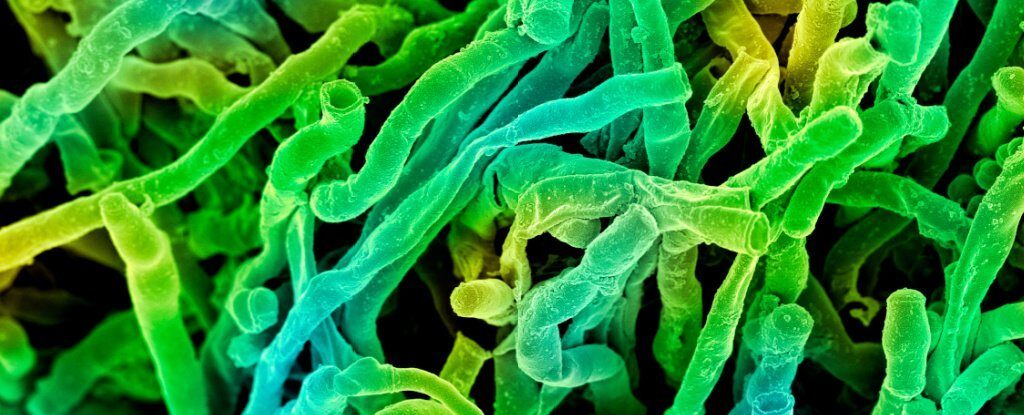
© (Science Photo Library/Getty Images)
The hunt for new and potentially potent therapeutic molecules in nature is a vital quest spurred on by parallel health crises: antibacterial resistance and the
growing global cancer burden.
Now, a team of scientists has discovered that a rare soil microbe produces some peculiar yet familiar molecular 'building blocks' with drug-like activity. This could be a boon for drug design and discovery programs.
"Our genomics-based approach allowed us to identify an unusual peptide for future drug design efforts,"
says Joshua Blodgett, a microbiologist at Washington University in St. Louis and senior author of the new study.
The focus of their exploration was
a group of spindly, soil-dwelling bacteria called actinomycetes, which lucky for us are prolific producers of medicinal compounds.
"Once thought to be largely devoid of new drugs, [genome sequencing] technologies revealed a deep trove of yet-undiscovered drug-like molecules hidden in actinobacterial genomes," the team
writes in their paper, led by pharmacologist Chunshun Lia from the University of Hawaii.
In actinomycetes, scientists have found the building blocks for more than 50 percent of antibiotics used today in clinics and hospitals, including the first active agent against tuberculosis, plus a host of anti-cancer drugs and immunosuppressants.A rekindled interest in exploring actinomycetes as rich sources of bioactive molecules has been fueled by the global health threat of antimicrobial resistance, which is spawning drug-resistant infections faster than new drugs can be produced. 'Superbug' infections are now the
third leading cause of death worldwide, according to a sobering analysis from earlier this year.
So, in the search for new drug candidates, Blodgett, Lia and colleagues turned their attention and their genome sequencing tools to
one particularly rare actinomycete, which was found in soils in China and goes by the name of
Lentzea flaviverrucosa.
Being
more difficult to find in nature than other actinomycetes, and harder to grow in the lab,
L. flaviverrucosa has not been studied nearly as much as its more common drug-producing relatives. And what the researchers found was quite odd.
"It has unusual biology, encoding for unusual enzymology, driving the production of unexpected chemistry, all harbored within a largely overlooked group of bacteria," says Blodgett of
L. flaviverrucosa.The team's earlier attempts to scan the genomes of rare actinomycetes had suggested
L. flaviverrucosa might make a few small, circular molecules called piperazyl molecules, which have been known to serve as useful scaffolds for synthesizing drugs.
Using a battery of techniques, the researchers discovered that
L. flaviverrucosa actually produces two types of piperazyl molecules. But these newfound compounds were different, produced by a single set of genes called a supercluster."At a high level, it looked as if one region of the genome might be able to make two different molecules," Blodgett
says.
"Usually, we think of a gene cluster [as] groups of genes that are like blueprints for making individual drug-like molecules. But it looked like there was almost too much chemistry predicted within this single cluster."
Once the researchers resolved the molecular structures of the two peculiar compounds, they also soon realized that one of them was quite unlike any described before. It consisted of two hexagonal molecules joined together to form a lopsided, asymmetric duo, which had potential drug-like activity when tested against certain types of human cancer cell lines.
"Nature is welding two different things together,"
explains Blodgett. "And, as it turns out, against several different cancer cell lines, when you stick A and B together, it turns into something more potent."
Of course, we mustn't forget that testing drugs on lab-grown cell lines is a world away from treatments showing therapeutic benefit in clinical trials. Plus, it takes decades for potential drug candidates to make their way from the lab through testing and into the clinic, and many fail in the process.
"Much more work, focus and funding are needed for the novel approaches to result in effective antibacterial therapies to sustainably combat antibacterial resistance," Ursula Theuretzbacher, an independent antibacterial drug expert, and colleagues
wrote in 2019.
Still, the hope is that with more analyses like this one, which seek to identify which bacterial strains hold the most promise and which compounds are most likely to succeed, researchers are on the right track, with no time to lose.
The research was published in
PNAS (link not yet live at time of writing).
Comment: Notably, Ivermectin, considered by the WHO to be an essential medicine because of the plethora of its uses and its demonstrable safety and efficacy, was also discovered in soil, but this time in Japan.
See also: